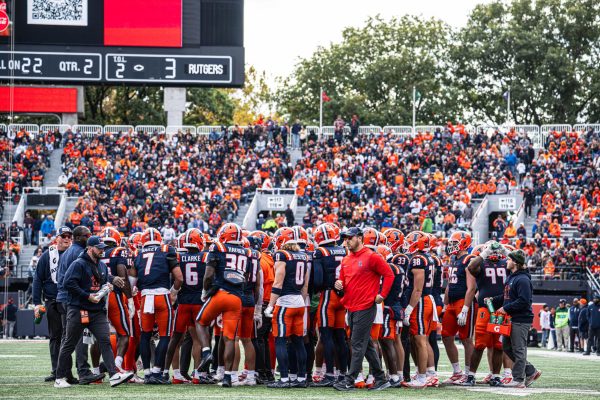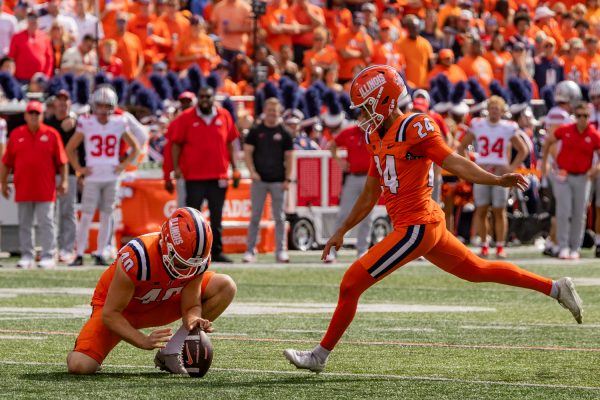University students and professors create satellite family
Mar 12, 2017
While University students are known for having their heads in the clouds, some engineering students and professors have theirs even higher.
IlliniSat-2 is a family of satellites that is being created by University students and professors. There are five satellites total: LAICE, CubeSail, Sassi2, Space Ice, and CapSat.
IlliniSat-2, implicitly, is the successor of IlliniSat-1. IlliniSat-1 had only one satellite, ION1. Launched in 2006 out of Russia, the satellite’s launch vehicle had a failure, which caused an explosion. While the design of the satellite was fine, the launch vehicle was flawed, and ION1 never made it to space.
“It was very disheartening to a lot of the team at the time,”Alexander Ghosh, a Systems Integration and Testing Manager for IlliniSat-2 and adjunct research assistant professor, said. “Around 2007, a new team of almost fresh students came in, and said ‘What are we going to do next’? So we looked at the design mentality of ION1, not that it exploded, and said that we could do better. Then, we started outlining what would be IlliniSat-2.”
Ghosh explained the commonality between the IlliniSat-2 family, and how they originated.
Get The Daily Illini in your inbox!
“We have about a third of a section of the satellites that is the same to all of them.” Ghosh said. “The idea of having this family that we can build the same way many times, and then put in different science experiments.”
Ghosh explained the advantage behind developing a family of satellites, rather than simply an individual.
“The advantage to the family concept is that we started with LAICE and CubeSail, but then we pitched to NASA that we wanted 3 more, and explained their science missions,” Ghosh said. “They said that since we’re so far along with these, making 3 more with the same design is a good idea.”
LAICE, an acronym for lower atmosphere ionosphere coupling experiment, is the largest of the group. It is launching first, with a launch scheduled for August. The process of creating LAICE has not been a short one.
According to Gary Swenson, a professor in the department of electrical and computer engineering, LAICE has been being worked on by a series of students over the course of many years.
“LAICE has been a program that we’ve been working on for four years.” Swenson said. “But the infrastructure that goes into IlliniSat has been going on with students since about 2006.”
According to Ghosh, LAICE will launch out of Kennedy Space Center, located in Cape Canaveral, Florida. Primarily, the National Science Foundation has provided the funding, while NASA is providing a free launch.
“LAICE is the biggest satellite we’ve built so far,” said Ghosh. “The National Space Foundation has given us about a million dollars to build LAICE over the past 5 years.”
The primary goal of LAICE is to look at the phenomena of airglow, which is demonstrated in the Northern Lights, and to learn more about how it occurs.
Many engineering students have contributed to the creation of LAICE, along with students and faculty at Virginia Tech.
“The energy is there, and everyone is committed to seeing this thing work,” Swenson said. “It’s a University of Illinois, student built thing, and we’re very proud of that.”
All technology is constantly changing, and satellite technology is no exception. The technology in ION1 was much different than the technology being used in IlliniSat-2.
“ION1 was a single mission, and everything was tightly integrated and very hard to diagnose or take apart,” Ghosh explained. “We really wanted the IlliniSat-2 mission to be scalable and modular, so we could take out parts and put in a replacement if something went wrong. That’s also what enables us to put different science missions in, because we treat the science missions as a different component.”
IlliniSat-2 was worked on in class by students up until this school year. Professor Swenson began the class with a co-worker in 2000. This year, students have taken different routes to being involved with IlliniSat-2. Through volunteering, RSOs and other coursework.
Swenson explained that the technology in IlliniSat-2 is useful to learn for students in multiple areas of engineering.
“Its interdisciplinary. There’s aerospace engineers, there’s electrical engineers, there’s computer engineers, and they all have to be taking to each other,” Swenson said. “It’s really exciting since it’s all starting to come together.”
Emilio Gordon, a sophomore in aerospace engineering, became involved through the RSO SatDev, or Satellite Development Organization. After becoming involved with the satellites, he took it upon himself to create his own class.
“I organized and teach the AE199 class. Last semester I came up with the idea of having a class to introduce new students,” Gordon said. “When I was a freshman myself, I found it difficult to join SatDev, so I wanted to help students not worry about what they don’t know yet.”
Gordon credits much of his knowledge that he shares in AE199 to SatDev. and currently is working on the thermal simulations of LAICE.
Gordon explained how working on LAICE has benefited him in school.
“What you learn in class is very different than what you do on the team. There are a lot of different elements that come into this, because this is a real scientific mission,” Gordon said. “It adds to a different perspective of things. If I’m in class and something is brought up, I’m instantly reminded of CubeSat, rather than just the general concept.”
All 5 satellites are being launched to answer different scientific questions, and all are partnered with different Universities and companies to aid in bringing the satellites to life. While LAICE is partnered with Virginia Tech, CubeSail is with an engineering company, Sassi2 is with Purdue and SpaceIce is with Northwestern.
With the launch of LAICE, there is a lot of knowledge to be gained.
“As we’re up for maybe 2 years, we’ll have a lot of opportunities as the satellite goes around the planned every hour and a half, or 16 times per day,” Swenson said. “We very frequently will make global observations of the phenomenon we’re studying.”
Through hard work, commitment and time, University engineering faculty and students will have a product up in space this summer.





